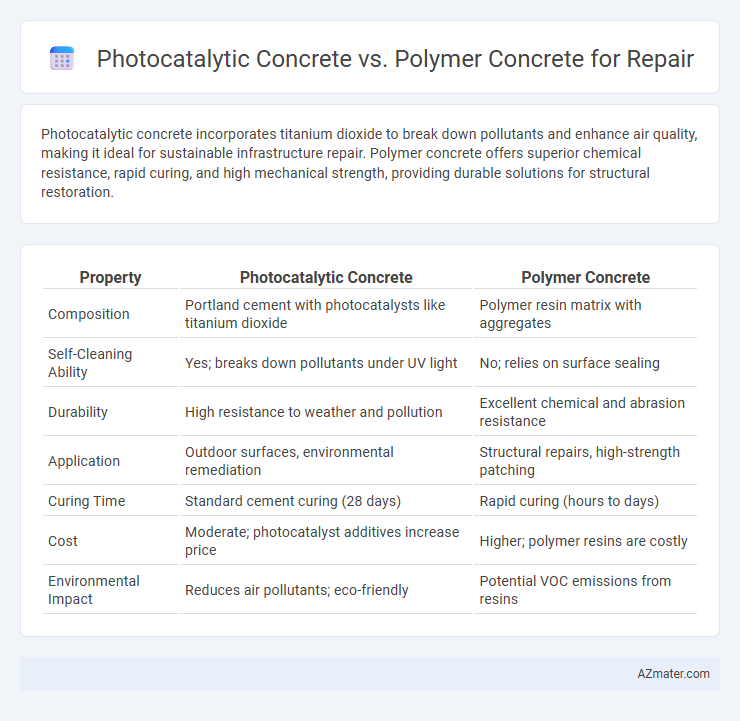Photocatalytic concrete incorporates titanium dioxide to break down pollutants and enhance air quality, making it ideal for sustainable infrastructure repair. Polymer concrete offers superior chemical resistance, rapid curing, and high mechanical strength, providing durable solutions for structural restoration.
Table of Comparison
| Property | Photocatalytic Concrete | Polymer Concrete |
|---|---|---|
| Composition | Portland cement with photocatalysts like titanium dioxide | Polymer resin matrix with aggregates |
| Self-Cleaning Ability | Yes; breaks down pollutants under UV light | No; relies on surface sealing |
| Durability | High resistance to weather and pollution | Excellent chemical and abrasion resistance |
| Application | Outdoor surfaces, environmental remediation | Structural repairs, high-strength patching |
| Curing Time | Standard cement curing (28 days) | Rapid curing (hours to days) |
| Cost | Moderate; photocatalyst additives increase price | Higher; polymer resins are costly |
| Environmental Impact | Reduces air pollutants; eco-friendly | Potential VOC emissions from resins |
Introduction to Photocatalytic and Polymer Concrete
Photocatalytic concrete incorporates titanium dioxide nanoparticles that activate under UV light, breaking down pollutants and enhancing environmental self-cleaning properties. Polymer concrete combines polymer binders with aggregates, offering superior chemical resistance and rapid curing compared to traditional cement-based materials. Both materials serve distinct roles in repair by improving durability and environmental performance, with photocatalytic concrete primarily targeting pollutant degradation and polymer concrete emphasizing structural restoration.
Composition and Chemical Structure
Photocatalytic concrete incorporates titanium dioxide (TiO2) as a photocatalyst within its cementitious matrix, enabling it to break down pollutants through photocatalytic oxidation when exposed to UV light. Polymer concrete consists of a resin binder, such as epoxy, polyester, or vinyl ester, combined with aggregates, providing enhanced chemical resistance and mechanical bonding due to its cross-linked polymer chains. The chemical structure of photocatalytic concrete depends on inorganic cement hydration products integrated with TiO2 nanoparticles, while polymer concrete relies on organic polymer networks that cure to form a durable composite ideal for repair applications.
Mechanisms of Action in Repair Applications
Photocatalytic concrete employs titanium dioxide nanoparticles that activate under UV light to break down organic pollutants and enhance self-cleaning properties, facilitating surface repair by preventing deterioration and maintaining structural integrity. Polymer concrete relies on resin binders such as epoxy or polyester to chemically adhere to damaged areas, forming a strong, flexible bond that restores load-bearing capacity and resists chemical and moisture ingress. Both materials offer unique mechanisms: photocatalytic concrete targets surface-level contamination and microcrack mitigation through photocatalysis, while polymer concrete provides mechanical reinforcement and sealing through polymerization and cross-linking reactions.
Durability and Longevity Comparison
Photocatalytic concrete features titanium dioxide additives that enhance self-cleaning properties and resist surface wear, contributing to prolonged durability in urban environments. Polymer concrete offers superior chemical resistance and reduced permeability, which effectively prevents water ingress and freeze-thaw damage, thereby extending repair lifespan. Comparative studies indicate polymer concrete generally outperforms photocatalytic concrete in structural longevity, but photocatalytic variants provide added environmental benefits through pollution reduction.
Environmental Impact and Sustainability
Photocatalytic concrete reduces air pollution by breaking down harmful pollutants such as nitrogen oxides, enhancing urban air quality through its self-cleaning and contaminant-degrading properties. Polymer concrete, while offering high durability and chemical resistance for repairs, relies on synthetic resins derived from non-renewable petroleum sources, raising concerns about its carbon footprint and long-term sustainability. Photocatalytic concrete provides a more eco-friendly solution by contributing to reduced emissions and extending infrastructure lifespan, aligning with sustainable construction goals.
Performance Under Harsh Conditions
Photocatalytic concrete excels in harsh environments due to its self-cleaning and pollution-reducing properties, effectively breaking down organic contaminants and reducing surface degradation under UV exposure. Polymer concrete offers superior chemical resistance and mechanical strength, maintaining integrity in corrosive or freeze-thaw conditions where traditional cementitious materials often fail. Both materials provide enhanced durability, but photocatalytic concrete is preferable for urban pollution mitigation, while polymer concrete is optimal for structural repairs subjected to aggressive chemicals and extreme weather.
Cost Analysis and Economic Considerations
Photocatalytic concrete offers long-term cost benefits by reducing maintenance expenses through self-cleaning and pollution-degrading properties, despite higher initial investment compared to polymer concrete. Polymer concrete entails lower upfront costs and faster curing times but may require frequent repairs due to lower durability in harsh environmental conditions. Economic considerations favor photocatalytic concrete for sustainable infrastructure projects where lifecycle analysis and environmental impact reduction justify higher initial costs.
Ease of Application and Workability
Photocatalytic concrete offers excellent ease of application due to its similar workability to standard concrete mixes, allowing for seamless integration in repair projects without requiring specialized equipment. Polymer concrete provides superior workability with enhanced fluidity and faster curing times, enabling quick application and minimal downtime during repairs. Both materials facilitate efficient repair processes, but polymer concrete typically excels in rapid placement and adaptability in complex surface contours.
Maintenance Requirements Over Time
Photocatalytic concrete reduces maintenance needs by breaking down pollutants and preventing surface degradation, extending lifespan without frequent cleaning. Polymer concrete offers high chemical resistance and durability, minimizing repairs but may require periodic inspections to ensure polymer integrity under environmental stress. Both materials improve long-term performance, yet photocatalytic concrete excels in self-cleaning properties, whereas polymer concrete provides superior structural resilience.
Case Studies and Real-World Implementations
Photocatalytic concrete has demonstrated significant pollution-reducing benefits in case studies like Japan's Shinjuku Square, where titanium dioxide coatings effectively break down NOx emissions, enhancing urban air quality. Polymer concrete, showcased in bridge deck repairs in the United States, excels in rapid curing and high durability, providing long-lasting structural resilience against chemical and environmental stressors. Real-world implementations reveal photocatalytic concrete's environmental advantage in pollution mitigation, while polymer concrete is favored for accelerated repair timelines and superior mechanical performance.

Infographic: Photocatalytic concrete vs Polymer concrete for Repair
 azmater.com
azmater.com